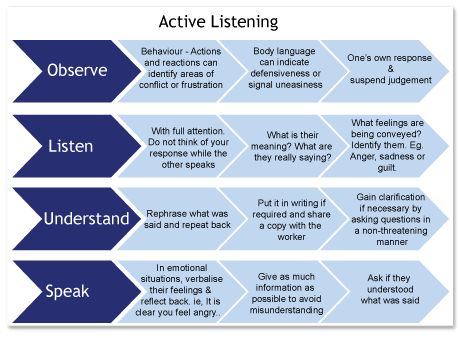| Show/Hide Hidden Text |
The Key Elements |
||||||||||||
|
Regular communication is vital to effective injury management. Talk to the injured worker, the doctor, supervisors and co-workers. Encourage co-workers to communicate. Use 'Active Listening' techniques to ensure everyone is on the same page, stay in control of the flow of communication:

Is the employee satisfied with their care?
How is the worker going? Are they satisfied with their treatment, with you, the support offered? Encourage your worker to take control of their recovery through an active and positive approach to their treatment. Encourage them to ask questions in order to understand their injury and feel comfortable in being upfront and honest about their needs. If the employee is not happy with their treater, explain they have the choice of treater. |
Are you satisfied with the care your employee is receiving?
Has the doctor explained to the worker that there will be an acceptable level of pain in the recovery process and that fear and avoidance of painful activities could cause more harm? Have the benefits of work as therapy been discussed? |
Forms, forms and forms |
Incident forms Must always be used and kept on record. Download sample incident report in word format Claim forms The worker needs to understand it is their decision whether to lodge a claim. Medical forms Restrictions listed on medical certificates are the first step in negotiating work duties. Restrictions can be discussed and may need clarification with the doctor. |
![]() What's next?
What's next?
Return to work management